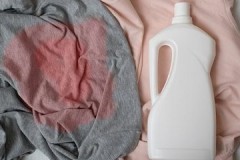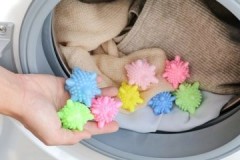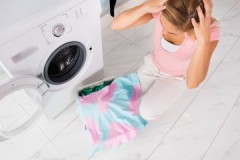Is it possible and how to wash kigurumi in a machine and by hand?
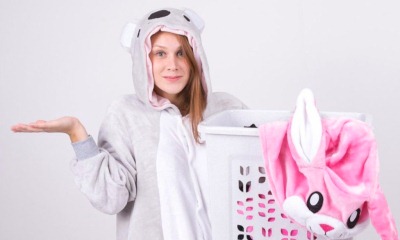 Modern costumes called "kigurumi" are worn by both adults and children. To prolong the enjoyment of your favorite item, you need to take proper care of it.
Modern costumes called "kigurumi" are worn by both adults and children. To prolong the enjoyment of your favorite item, you need to take proper care of it.
A competent choice of detergents, stain removers, washing mode, drying method allows you to keep the shape and color of the overalls.
Timely delicate cleaning of the pile does not affect the texture and thermal qualities of the material.
Is it possible and how to properly wash kigurumi in the washing machine and by hand? Details are in the article.
Content
What fabrics are they made of?
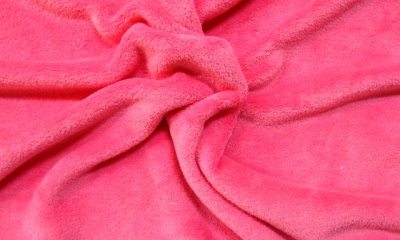 For sewing plush overalls, both synthetic and natural fabrics are used:
For sewing plush overalls, both synthetic and natural fabrics are used:
- velsoft,
- fleece,
- polyester,
- velours,
- flannel.
Soft velsoft has good hygroscopicity, but also quickly releases moisture. These qualities are important when washing and drying the product.
Fleece is a denser fabric with less moisture absorption. Both materials have excellent texture retention, as they practically do not roll.
Velsoft, fleece and velor on a knitted basis do not shrink after soaking... They do not wrinkle after washing and therefore do not require ironing. At the same time, velsoft is softer than fleece and holds its shape a little worse.
After prolonged wear and several washes, the velsoft pajamas may sag a little. Subject to the rules of synthetic velvet kigurumi can be washed in the machine.
Some summer models of pajamas are made from pure cotton fabric.... With all the obvious advantages (environmental friendliness, hygroscopicity), the material has some operational limitations.
Detergent selection
For overalls, liquid detergents and laundry soap without fragrances or dyes are suitable. Do not use bleaches, liquids with chlorine and other aggressive substances. Use a concentrated conditioner for rinsing.
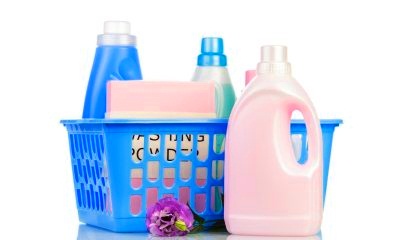 Liquid products of the brand have proven themselves well:
Liquid products of the brand have proven themselves well:
- Sodasan,
- Lavel,
- Cotico Baby,
- Baby Line,
- Weasel,
- Eared Nian.
When choosing a product, they are guided by the washing method (manual or automated), the type of fabric, as well as the degree of soiling.
Laundry soap is known to have some bleaching effect. This property should be taken into account in the presence of darkening or stains on the fabric.
Preparation for the process
Before starting the washing process, you must read the instructions for the clothes... It is presented briefly on the label on the wrong side.
The icons and numbers indicate which mode and washing conditions are possible for a given product. At the same time, for kigurumi there are general rules for preparing for washing.
Separate local contamination should be pretreated with a neutralizing agent.... A subsequent wash will remove any remaining dye and cleaner from the fabric.
Before putting the overalls into a washing machine drum or basin, check its pockets. The pajamas are turned inside out. This measure protects the pile from abrasion. In conclusion, the kigurumi is fastened with all buttons.
Step-by-step instruction
Products with velvety pile are not recommended to be dry-cleaned... Manufacturers of unusual costumes recommend giving preference to hand washing. This is especially true for models with plastic parts on the hood. They may come off or come off as the drum rotates.
What is the correct way to do this in a washing machine?
Kigurumi should be washed separately from other items. The detergent must be suitable for the machine. The process sequence is the same for any type of fabric.
The only differences are in the choice of mode and temperature setting:
 Thing put in the drum... The detergent is added to the main wash compartment. The average amount of liquid for one overalls is from 50 to 100 ml, depending on the degree of contamination.
Thing put in the drum... The detergent is added to the main wash compartment. The average amount of liquid for one overalls is from 50 to 100 ml, depending on the degree of contamination.- To the rinse aid compartment pour a portion of the conditioner... It will give the fabric extra softness and eliminate static charge during wear.
- For kigurumi made of velvety fabrics set the mode “Delicate wash of synthetics”, from cotton - “Delicate wash of cotton”. Temperature for fleece and cotton is maximum 40 degrees, for velsoft and polyester - maximum 30 degrees.
- Disable the "spin" function... If such an opportunity is not provided in the washing machine, you should check the process yourself and turn off the machine after the last rinse.
Hand wash
This method is more time consuming, but more delicate in relation to the fabric and cut of the pajamas. Detergents are chosen at their discretion from the list of recommended ones, since in this case there are no restrictions.
Hand washing is carried out according to the following scheme:
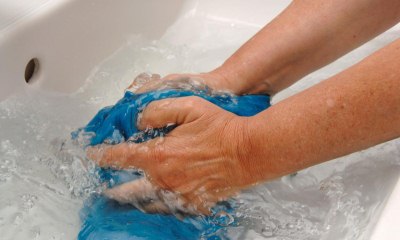 Warm water is poured into a basin or a bathtub (for fleece, cotton - 40 degrees, for velsoft, polyester - 30 degrees). Dissolve the detergent in it. For kigurumi made of fleecy synthetics, a large volume should be poured, since the fabric absorbs a lot of water.
Warm water is poured into a basin or a bathtub (for fleece, cotton - 40 degrees, for velsoft, polyester - 30 degrees). Dissolve the detergent in it. For kigurumi made of fleecy synthetics, a large volume should be poured, since the fabric absorbs a lot of water.- They put the suit in the container and let it get completely wet. Leave the thing for 20-30 minutes to soak.
- Kigurumi is washed with soft squeezing movements, periodically turning over. The most soiled areas on a cotton suit can be rubbed lightly with your hands.
- The product is rinsed 2-3 times in clean water. At the last stage, conditioner is added to the container. Wring out without twisting.
If the liquid is very cold after soaking, add a little hot water and soap. Before this, the suit must be removed from the basin so that hot water does not get onto the fabric.
How to dry?
After the jumpsuit has been washed and the excess water wrung out, it is laid out on a dry, dense fabric that absorbs moisture well... Dry at room temperature. All buttons and zippers are fastened on the suit to completely straighten all the details.
When the fabric is dry, the suit can be hung on the bar for final drying.Synthetic velvet dries very quickly, so it doesn't take much time to dry. Cotton overalls require a slightly longer drying time.
Removing stains
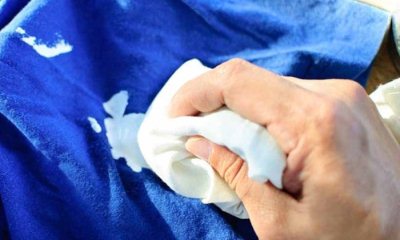 Plush fabric structure makes it easy to remove stubborn dirt... If serious dyes are to blame for the appearance of the stain: greens, wine, coffee, tea or fat, then it is recommended to use special formulations.
Plush fabric structure makes it easy to remove stubborn dirt... If serious dyes are to blame for the appearance of the stain: greens, wine, coffee, tea or fat, then it is recommended to use special formulations.
To remove a fresh greasy or oily stain, the cloth is wiped with a swab dipped in diluted ammonia. The proportion of the solution is 1: 1.
To lighten grass traces, use a non-standard "bleach" - a gauze dressing with peroxide impregnation... Coffee, chocolate and tea stains can be removed with super concentrated salt solution.
To remove the trail from the baby slime, the suit is placed in the freezer. After freezing, the dirt is gently scraped off with a spoon or blunt knife.
Errors when washing
Using hot water leads to a deterioration in the quality of the pile and the appearance of a gray-yellow color... At the same time, cold water also creates a problem - the thing is not washed. The only way out can be strict adherence to the temperature regime.
The third common mistake is ignoring the gentle spin of the product.... Regular twisting by hand or using a centrifuge will deform the kigurumi. Excess water removal and drying should be done according to the rules.
Conclusion
 Delicate fabrics and intricate kigurumi cuts require careful handling during washing and removing stains.
Delicate fabrics and intricate kigurumi cuts require careful handling during washing and removing stains.
It is recommended to remove dirt from a fleecy surface with special mild agents, followed by application of a conditioner.
The choice between manual and automatic washing is up to you.... The most important thing in this business is to comply with all conditions and rules, in this case the jumpsuit will delight its owner for a long time.

